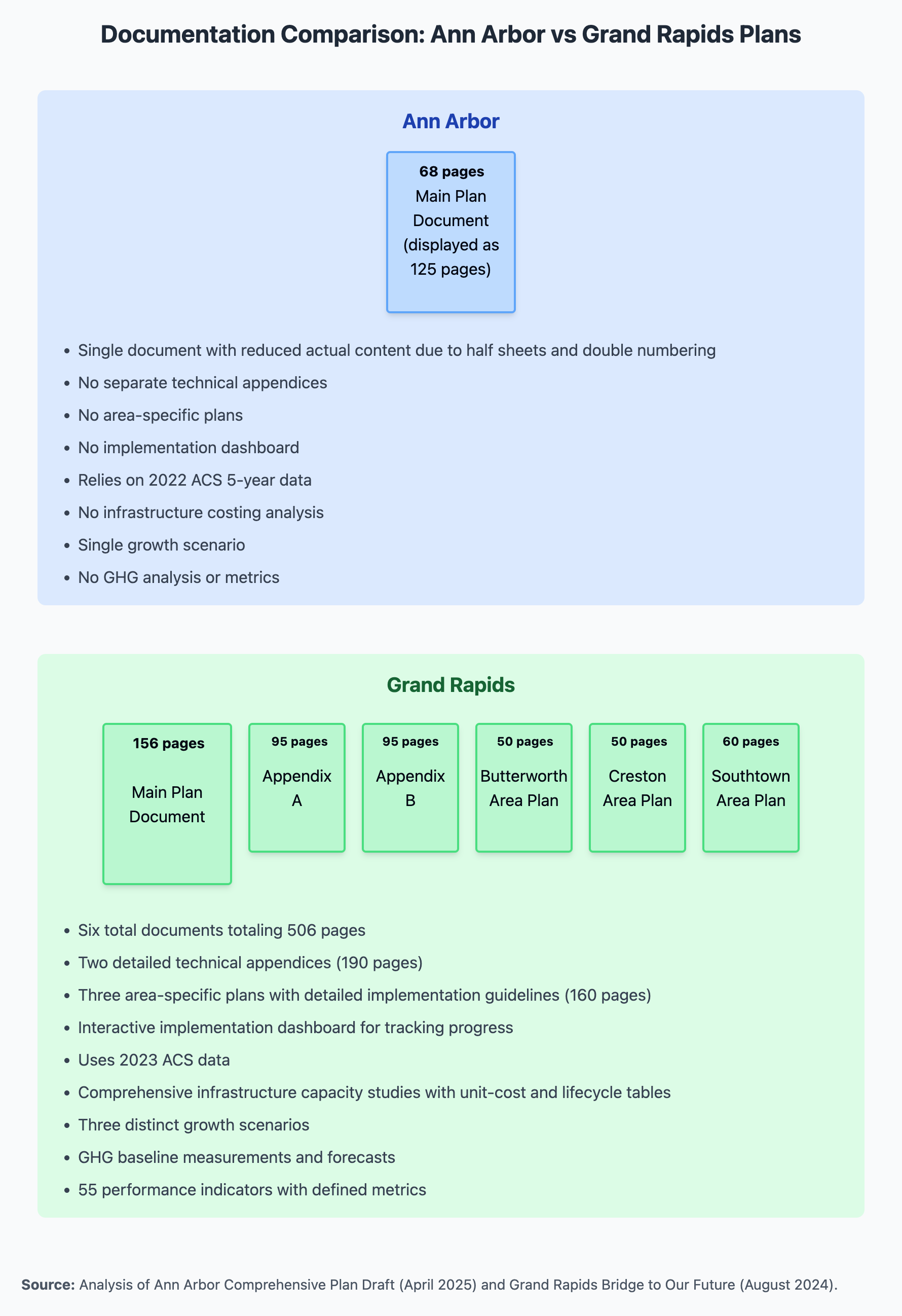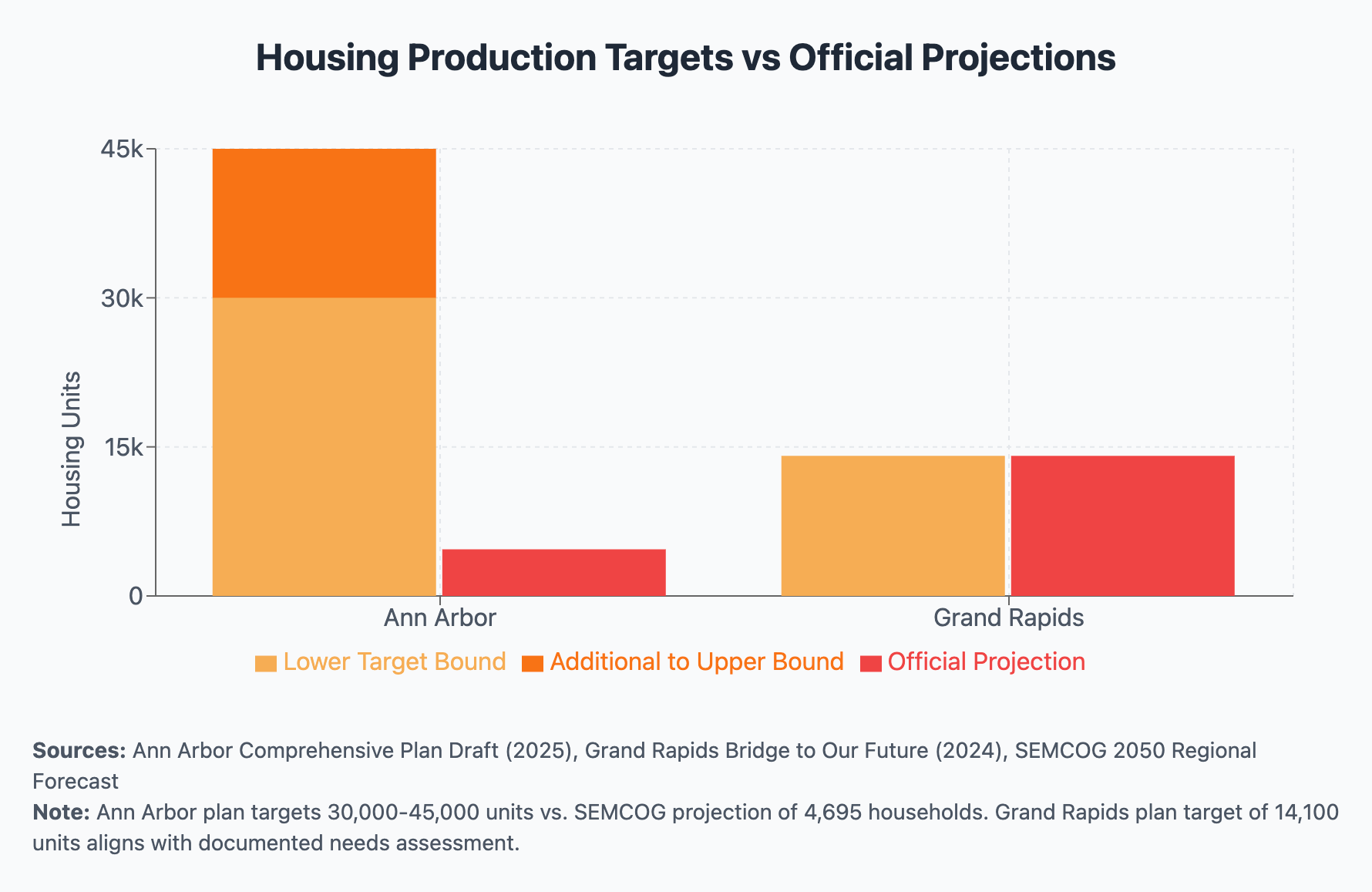A Tale of Two Plans
Ann Arbor vs. Grand Rapids:
It's eye-opening to compare Ann Arbor's draft plan (April 2025) with Grand Rapids' draft plan (August 2024)—especially since both cities hired the same consulting firms: Interface Studios and Ninigret Partners. The 11-person Pittsburgh based firm, Interface Studios, also sub-contracted work on the A2 plan to the international firm SmithGroup and New Orleans based &Access. Founded in Ann Arbor in 1853, SmithGroup’s 172 years of work and 1,500 employees are renowned for their work in Ann Arbor and Metro Detroit.
Grand Rapids invested four years in their "Bridge to Our Future" plan, producing a 506-page planning suite that includes a 156-page main document, 190 pages of appendices, and three 50-page area-specific plans. They engaged over 4,700 residents and formed a demographically representative 50-person Steering Committee to guide the work. (GR Appendix A) (GR Appendix B) (GR Butterworth) (GR Creston) (GR Southtown)
Ann Arbor's process was rushed through in 15 months with a much smaller 16-person committee. The brochure style document appears to be 125 pages, but actually contains fewer than 68 pages of real content due to half sheets and double numbering. Yet it proposes adding 30,000-45,000 new housing units—a target that's 600% to 900% times higher than the official SEMCOG projection of 4,695 households—without substantial technical analysis to support these ambitious numbers. These differences matter when we're making decisions that will shape our city for decades to come.
Summary:
The technical foundation of these plans reveals stark differences in planning rigor and transparency. Ann Arbor's draft relies on outdated baseline data—pre-dating the Statewide Housing Plan launch and missing crucial 2023 updates. Without current vacancy statistics or a data-driven absorption schedule, the extraordinary growth projection (600-900% above SEMCOG forecasts) stands on shaky ground. The plan presents a single preferred land-use scenario without alternatives for comparison.
Most critically, it lacks infrastructure capacity assessments or cost analyses. There's no connection to Ann Arbor's FY 2026-31 Capital Improvements Plan and no acknowledgment of electrical grid limitations that could affect near term development feasibility, and no costed expansion and utility rate impacts. There’s no connection to the Ann Arbor Water Strategic Plan (Feb. 2024, Adopted by Council) Capacity Evaluation which openly states in a 4/11/2025 memo by OHM Advisors, that all current capacity planning is based on SEMCOG projections.
Grand Rapids took a fundamentally different approach. Their plan includes comprehensive technical appendices referencing ACS 2023 data tables, local cohort forecasts, and their 2023 Housing NEXT gap study. They developed three distinct land-use scenarios with accompanying lifecycle infrastructure assessments and greenhouse gas emission calculations for each option. Their plan establishes 55 key performance indicators aligned with Planning Advisory Service Report 578 best practices—a framework completely absent from Ann Arbor's document.
Without an evidence-based Inventory & Analysis addendum, Ann Arbor residents lack the tools to evaluate whether the proposed growth aligns with actual demographic trends, available infrastructure capacity, fiscal constraints, or our climate commitments.
Bridge to Our Future Online Plan:
In addition to getting over 430 more pages of real planning than Ann Arbor in their first draft, Grand Rapids also received an online version of their Comprehensive Plan. Where’s all the content we paid for? It’s ALL in the scope of work, paid for, but no residents have seen it…
📢 Make your voice heard by contacting the A2 City Council and Planning Commission - Demand they Pause the Plan!
Contact an individual Ann Arbor City Council Member, or all:


